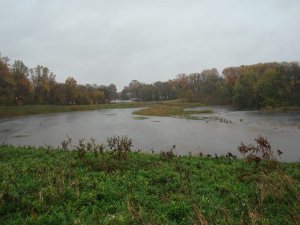Using green infrastructure is an important strategy in our nation’s adaptation to climate change.

Using green infrastructure is an important strategy in our nation’s adaptation to climate change. Greening Wheaton, therefore, not only creates a beautiful, more people-friendly community, but it will help us adapt locally to our rapidly changing climate.
What does climate change mean in our region? According the 2008 Comprehensive Assessment of Climate Change Impacts in Maryland, we can expect (and we have started seeing) temperature increases and more extreme precipitation events such as heavy downpours and floods, interspersed with droughts. In addition to climate change, land use changes have also contributed to heat island effects, localized warming in urban areas, and flooding.
I noticed that during the hard rain of Hurricane Sandy nearly everyone was inside their homes, warm, dry, and completely unaware of what occurs when we have heavy rains. Most are just as unaware of what increased precipitation and flooding could mean to Wheaton in the future. As far as most Wheaton residents are concerned, when it rains, the runoff simply disappears into storm drains.
What actually happens is quite interesting, and the knowledge of what happens is useful in planning climate change adaptation in urban areas. In most of the Wheaton Central Business District (CBD), if everything is working properly, the runoff goes down the stormdrains and is quickly carried by way of stormwater mains to the Wheaton Branch Stormwater ponds along Dennis Ave.
During heavy rains, the three ponds fill up and becomes a lake. A stormwater control structure at one end ofthe ponds slowly lets stormwater out of the ponds and into Wheaton Branch and eventually into Sligo Creek, thus helping to prevent flooding downstream. An earthen dam keeps the rising water level of the lake from flooding the residential areas in the Forest Estates community. The water level in the ponds is monitored to help protect the homes downstream of the earthen dam. When there is an unusually heavy rain, the amount of water draining from the ponds increases. If there is an extreme rain event like our ever increasing “100-year storms”, the homes downstream from the dam may need to be evacuated.
Is there anything we can do locally to help locally to adapting to climate change and its impacts? According to recent scientific reports, adding 10% green infrastructure in high-density residential areas and in town centers keeps maximum surface temperatures lower and significantly reduces stormwater runoff.
Preserving our existing green space in and around Wheaton is vitally important. At the beginning of this blog, I used the term “green infrastructure.” What do I mean by green infrastructure? It means using natural systems such as soils and vegetation to provide ecosystem services such as providing clean drinking water, decomposition of waste and other public “goods” that can supplement or replace built services.
In existing urban areas like the Wheaton CBD, that means installing green roofs and green walls, tree plantings, and green street projects. Not only do we need to install green features, but we also need to become better stewards of our properties. It makes little sense to plant trees if we do not know how to maintain them or do not allow through on the maintenance.
Getting people to be better stewards of their properties may be our biggest challenge. Right before the hurricane many residents were raking their leaves into the gutter and in front of the storm drains completely oblivious to the fact that the leaves could help clog up the storm drains during a heavy rain. If you are interested in helping us green Wheaton, join GreenWheaton www.greenwheaton.org and follow us on Facebook.


